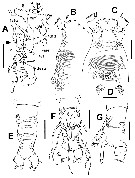|
|
 |
|
Monstrilloida ( Order ) |
|
|
|
Monstrillidae ( Family ) |
|
|
|
Cymbasoma ( Genus ) |
|
|
| |
Cymbasoma tranteri Suarez-Morales & McKinnon, 2016 (F) | |
| | | | | | | Ref.: | | | Suarez-Morales & McKinnon, 2016 (p.106, Descr. F, figs. F, Rem.) |  Issued from : E. Suarez-Morales & A.D. McKinnon in Zootaxa, 2016, 4102. [p.107, Fig.62]. Female (from 34°4.670'S, 151°9.100'E): A, right A1 (dorsal); B, cephalic region with arrow indicating medial process between A1 bases, left A1 omitted (lateral); C, same (ventral); D, detail of cuticular processes on ventral surface between A1 bases; E, urosome (dorsal); F, same (ventral); G, same (lateral). Scale bars: A-C, E-G = 100 µm; D = 50 µm. Nota: - Urosome (caudal rami not included) representing 12 % of total body length. Relative lengths of urosomites 32.6 : 40 : 27.4 = 100. - Ovigerous spines paired, separated at base, relatively long, 52 % of total body length; spines equally long. - Caudal rami not divergent, subrectangular, about 1.3 times as long as wide, armed with 3 caudal setae. - A1 representing about 16.2 % of total body length and 23.4 % of cephalothorax length; 4-segmented, relative length of distal segment 57 %. - P5medially conjoined, bilobate, outer (exopodal) lobe cylindrical, with distal rounded process. Inner lobe arising basally, thumb-like, reaching midlength of exopodal lobe. Outer lobe armed with 3 subapical setae, innermost seta longest.
|
 Issued from : E. Suarez-Morales & A.D. McKinnon in Zootaxa, 2016, 4102. [p.108, Fig.63]. Female: A, habitus (lateral); B, ovigerous spines; C, P1; D, P2 with intercoxal sclerite; E, P3 with inercoxal sclerite; F, detail of mammiliform outer spine on 3rd exopodal segment of legs (arrows in figuresC D indicates position of mammiliform spines. Scale bars: A = 500 µm; C-E = 100 µm; F = 50 µm. Nota: Cephalothorax representing 68 % of total body length. - Midventral oral papilla moderately protuberant, located at 15 % of cephalothorax length. - Pair of relatively large ocelli, pigment cups well developed, medially conjoined, separated by less than half an eye diameter, weakly pigmented; ventral cup as large as lateral cups. - Frontal sensilla absent.
|
 ssued from : E. Suarez-Morales & A.D. McKinnon in Zootaxa, 2016, 4102. [p.109]. Female: Armature formula of swimming legs P1 to P4.
| | | | | NZ: | 1 | | |
|
Distribution map of Cymbasoma tranteri by geographical zones
|
| | | | Loc: | | | SE Australia (Port Hacking, New South Wales)
Type locality: 34°4.670' S, 151°9.100' E. | | | | N: | 1 | | | | Lg.: | | | (1198)* F: 2,23; {F: 2,23}
* Body length measured from the anterior end cephalothorax to the posterior end of the anal somite. | | | | Rem.: | For Suarez-Morales & McKinnon (2016, p.110) the species can be distinguised from its Autralian congeners that have a P5 inner lobe shorter than the outer lobe by details of the armature of the outer lobe.. A distinctive apomorphy of C. tranteri is the peculiar mammiliform shape of the outermost spine of the 3rd exopodal segment of P1-P4, a character not previously observed in any other known Cymbasoma (see in fig. 63C-F) | | | Last update : 04/10/2016 | |
|
|
 Any use of this site for a publication will be mentioned with the following reference : Any use of this site for a publication will be mentioned with the following reference :
Razouls C., Desreumaux N., Kouwenberg J. and de Bovée F., 2005-2025. - Biodiversity of Marine Planktonic Copepods (morphology, geographical distribution and biological data). Sorbonne University, CNRS. Available at http://copepodes.obs-banyuls.fr/en [Accessed October 20, 2025] © copyright 2005-2025 Sorbonne University, CNRS
|
|
 |
 |





